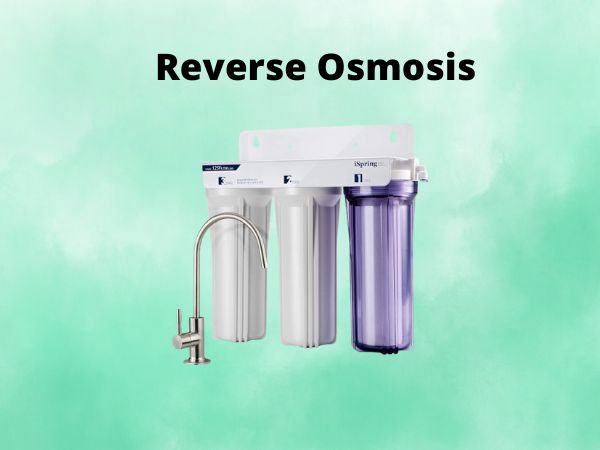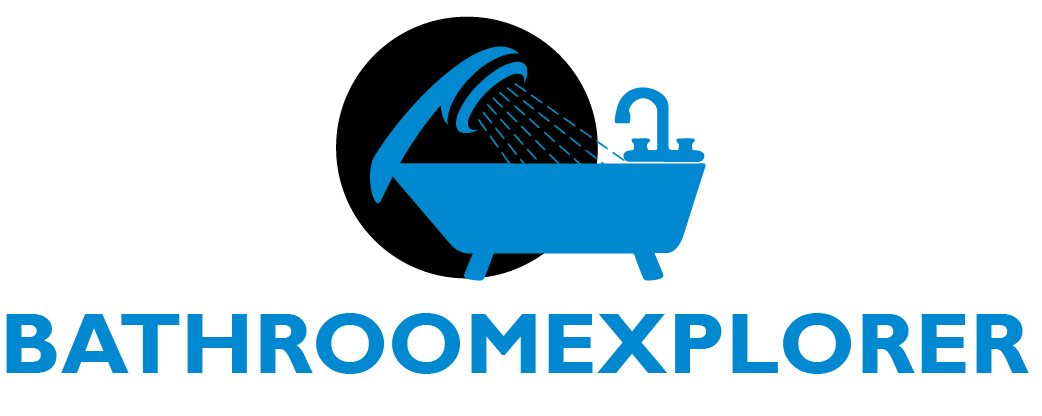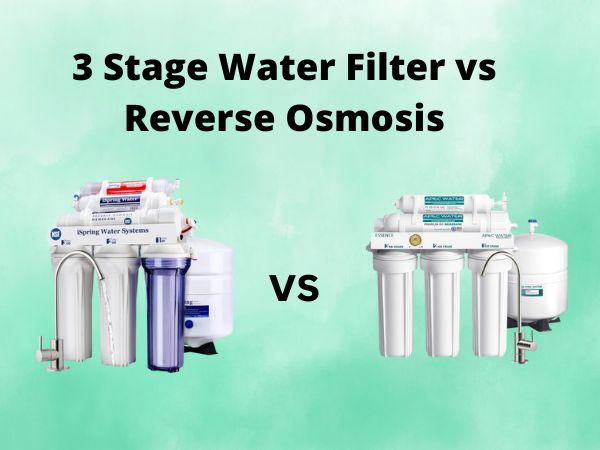3 Stage Water Filter vs Reverse Osmosis [Which One Should You Choose?]
When it comes to ensuring clean and safe drinking water for your household, investing in a reliable water filtration system is crucial. Two popular options are 3 stage water filters and reverse osmosis (RO) systems. In this article, we’ll dive deep into the details of each system, exploring their advantages and disadvantages to help you make an informed decision.
Table of Contents
Here is an in-depth comparison table for “3 Stage Water Filter vs Reverse Osmosis”:
| Comparison Factor | 3 Stage Water Filter | Reverse Osmosis System |
| Filtration Mechanism | Utilizes sediment, carbon block, and polishing filters to remove contaminants. | Uses a semi-permeable membrane to remove contaminants through reverse osmosis process. |
| Contaminants Removed | Effective at removing sediment, chlorine, rust, volatile organic compounds (VOCs), and some microorganisms. | Highly effective at removing a wide range of contaminants, including dissolved solids, heavy metals, bacteria, viruses, and other microscopic impurities. |
| Water Waste | Minimal water waste during filtration process. | Significant water waste during filtration process, typically 3-4 gallons of wastewater for every 1 gallon of purified water. |
| Installation | Relatively easy to install, often under the sink or at the point of use. | More complex installation, may require professional plumbing modifications and a dedicated faucet or tap. |
| Maintenance | Filters need to be replaced every 6-12 months, depending on usage and water quality. | Membrane and other components need to be replaced every 1-5 years, depending on usage and water quality. Regular system flushing and cleaning is also required. |
| Cost | Lower upfront and ongoing costs for filters and replacement. | Higher upfront costs for system and installation, as well as ongoing costs for membrane and component replacement. |
| Water Taste | Can improve taste by removing chlorine and other contaminants. | Can produce a flat or bland taste due to removal of minerals. |
| Water Flow Rate | Higher flow rate, providing faster water delivery. | Lower flow rate, slower water delivery. |
| Water Storage | No dedicated water storage tank. | Requires a storage tank for purified water. |
| Energy Consumption | No significant energy consumption. | Requires electricity to operate pumps and other components. |
| Water Quality Monitoring | No built-in water quality monitoring system. | Some systems include water quality monitoring and automatic shutoff features. |
| Remineralization | No remineralization process, may remove beneficial minerals. | Some systems include remineralization cartridges to add minerals back to the water. |
| Typical Applications | Suitable for improving taste, odor, and removing aesthetic contaminants. | Recommended for areas with poor water quality, or where removal of dissolved solids, heavy metals, and other contaminants is necessary. |
What is a 3 Stage Water Filter?
A 3 stage water filter is a point-of-use (POU) system that consists of three separate filtration stages. Each stage targets specific contaminants, providing a multi-layered approach to water purification. Here’s how the three stages work:

Stage 1: Sediment Filter
The first stage of a 3 stage water filter is the sediment filter, also known as a pre-filter. Its primary function is to remove larger particles, such as rust, dirt, and sand, from the incoming water supply. This filter helps to protect the subsequent stages and extend the lifespan of the entire filtration system.
Stage 2: Carbon Block Filter
The second stage is the carbon block filter, which is designed to remove chlorine, volatile organic compounds (VOCs), and other chemical contaminants that can affect the taste and odor of your water. Carbon block filters are highly effective in reducing a wide range of impurities, ensuring that your drinking water tastes fresh and clean.
Stage 3: Polishing Filter
The final stage of a 3 stage water filter is the polishing filter. This stage typically consists of a specialized media, such as a reverse osmosis membrane or an ultraviolet (UV) light, to remove any remaining contaminants and provide an extra layer of protection against microorganisms, like bacteria and viruses.
What is Reverse Osmosis (RO)?
Reverse osmosis (RO) is a more advanced and comprehensive water filtration technology that uses a semi-permeable membrane to remove a wide range of contaminants from water. Unlike a 3 stage filter, which primarily targets larger particles and chemical contaminants, an RO system is capable of removing dissolved solids, heavy metals, and even microscopic impurities.

The Reverse Osmosis Process
The reverse osmosis process involves forcing water through a semi-permeable membrane under high pressure. This membrane has pores so small that it can filter out contaminants as small as 0.0001 microns, including bacteria, viruses, and heavy metals like lead and mercury. The purified water passes through the membrane, while the contaminants are left behind and flushed away.
Components of an RO System
A typical reverse osmosis system consists of several components, including:
- Pre-filters: These remove larger particles, sediment, and chlorine from the incoming water supply to protect the RO membrane.
- Semi-permeable membrane: The heart of the RO system, where the actual filtration process takes place.
- Storage tank: Purified water is stored in this tank until it’s needed.
- Post-filter: An additional filter that polishes the purified water, removing any remaining tastes or odors.
- Automatic shut-off valve: Stops the system when the storage tank is full.
Factors to Consider When Choosing a Water Filtration System
When deciding between a 3 stage water filter and a reverse osmosis system, there are several factors to consider:
Water Quality
The quality of your water supply plays a significant role in determining the appropriate filtration system. If your water contains high levels of dissolved solids, heavy metals, or other contaminants, a reverse osmosis system may be the better choice as it can effectively remove these impurities. However, if your primary concern is chlorine, sediment, and other aesthetic contaminants, a 3 stage water filter may suffice.
Cost
Generally, reverse osmosis systems are more expensive than 3 stage water filters, both in terms of initial purchase and installation costs, as well as ongoing maintenance and replacement costs. However, the long-term savings on bottled water and the potential health benefits of purified water may justify the higher upfront investment for some households.
Installation and Maintenance
3 stage water filters are typically easier to install and maintain compared to reverse osmosis systems. They can often be installed under the sink or at the point of use, while RO systems require more extensive plumbing modifications and may need a dedicated faucet or tap.
Water Waste
Reverse osmosis systems generate a significant amount of wastewater during the filtration process, which can be a concern in areas with water scarcity or high utility costs. 3 stage water filters, on the other hand, produce relatively little wastewater.
Water Taste and Odor
Both 3 stage water filters and reverse osmosis systems can improve the taste and odor of your water by removing chlorine and other contaminants that contribute to unpleasant flavors and smells. However, some people find that RO water has a slightly flat or bland taste due to the removal of minerals.
Advantages and Disadvantages of 3 Stage Water Filters
Advantages
Removes Contaminants
While not as comprehensive as reverse osmosis, 3 stage water filters are effective at removing a wide range of contaminants, including sediment, chlorine, and volatile organic compounds (VOCs). This ensures that your drinking water is free from unpleasant tastes, odors, and many harmful impurities.
Cost-Effective
Compared to reverse osmosis systems, 3 stage water filters are generally more affordable, both in terms of upfront costs and ongoing maintenance expenses. The filters themselves are relatively inexpensive and can be easily replaced, making them a budget-friendly option for many households.
Easy Installation and Maintenance
One of the most significant advantages of 3 stage water filters is their ease of installation and maintenance. These systems can be installed under the sink or at the point of use without major plumbing modifications. Additionally, replacing the filters is a straightforward process that can be done by most homeowners.
Disadvantages
Limited Contaminant Removal
While 3 stage water filters are effective at removing many common contaminants, they may not be sufficient for removing dissolved solids, heavy metals, or other microscopic impurities. If your water supply contains high levels of these contaminants, a reverse osmosis system may be a better choice.
Potential for Bacteria Growth
If not properly maintained, 3 stage water filters can become a breeding ground for bacteria. This is especially true if the filters are not replaced according to the manufacturer’s recommendations or if the system is left unused for an extended period.
Frequent Filter Replacement
To maintain optimal performance, the filters in a 3 stage system need to be replaced regularly. Depending on your water usage and quality, this may need to be done every few months, which can add to the ongoing maintenance costs.
Advantages and Disadvantages of Reverse Osmosis Systems
Advantages
Comprehensive Contaminant Removal
Reverse osmosis systems are highly effective at removing a wide range of contaminants, including dissolved solids, heavy metals, bacteria, viruses, and other microscopic impurities. This makes them an excellent choice for households with poor water quality or specific contaminant concerns.
Consistent Water Quality
Once installed and properly maintained, reverse osmosis systems provide a consistent level of purified water, ensuring that your drinking water meets the highest standards of quality.
Improved Taste and Odor
By removing many of the contaminants responsible for unpleasant tastes and odors, reverse osmosis systems can significantly enhance the flavor and smell of your drinking water, providing a refreshing and crisp taste.
Disadvantages
Higher Costs
Reverse osmosis systems are generally more expensive than 3 stage water filters, both in terms of initial purchase and installation costs, as well as ongoing maintenance and replacement expenses. The cost of replacing the semi-permeable membrane and other components can add up over time.
Complex Installation and Maintenance
Installing a reverse osmosis system typically requires more extensive plumbing modifications and may require the expertise of a professional plumber. Additionally, maintaining an RO system can be more involved, with multiple components needing regular attention and replacement.
Water Waste
During the filtration process, reverse osmosis systems generate a significant amount of wastewater, which is typically flushed down the drain. This can be a concern in areas with water scarcity or high utility costs.
Longer Waiting Times
Reverse osmosis systems generally have a slower flow rate compared to 3 stage water filters, which means you may need to wait longer to fill a glass or container with purified water.
FAQs
- Can I install a 3 stage water filter or reverse osmosis system myself?
While 3 stage water filters are generally easier to install and can often be done by homeowners, reverse osmosis systems may require professional installation, especially if significant plumbing modifications are needed.
- How often do I need to replace filters or components in these systems?
The frequency of filter or component replacement depends on your water usage, water quality, and the specific system you have. Generally, filters in 3 stage systems need to be replaced every 6 to 12 months, while RO membranes and other components may last 1 to 5 years.
- Can a reverse osmosis system remove all contaminants from my water?
While reverse osmosis systems are highly effective at removing a wide range of contaminants, they may not remove 100% of all impurities. Some dissolved gases, like radon, may still pass through the membrane.
- Will a water filtration system remove beneficial minerals from my water?
Both 3 stage filters and reverse osmosis systems can remove some minerals from your water, which can affect the taste. If this is a concern, you may want to consider adding a remineralization cartridge or investing in a system that preserves some minerals.
- Can I use a reverse osmosis system for my entire home, or is it just for drinking water?
While reverse osmosis systems are primarily designed for drinking water, some larger whole-house systems are available. However, these can be costly and may require significant plumbing modifications.
Conclusion
When it comes to choosing between a 3 stage water filter and a reverse osmosis system, there is no one-size-fits-all solution. The decision ultimately depends on your specific water quality needs, budget, and personal preferences.
If your primary concern is removing chlorine, sediment, and other aesthetic contaminants, and you’re on a tight budget, a 3 stage water filter may be a suitable choice. These systems are cost-effective, easy to install and maintain, and can significantly improve the taste and odor of your drinking water.
However, if you’re dealing with more severe water quality issues, such as high levels of dissolved solids, heavy metals, or other microscopic contaminants, a reverse osmosis system may be the better investment. While more expensive and complex to install and maintain, RO systems offer comprehensive contaminant removal and can provide a consistent supply of purified water for your household.
Regardless of your choice, it’s essential to regularly maintain and replace the filters or components of your water filtration system according to the manufacturer’s recommendations. This will ensure that your system continues to operate effectively and provides you with clean, safe drinking water for years to come.


![What Is The Best LG Refrigerator Water Filters [In 2025]](https://bathroomexplorer.com/wp-content/uploads/2024/04/Best-LG-refrigerator-water-filter.jpg)
![3 Stage Vs 4 Stage Reverse Osmosis Filtration [in 2024]](https://bathroomexplorer.com/wp-content/uploads/2023/10/3-Stage-Vs-4-Stage-Reverse-Osmosis-Filtration-768x461.jpg)